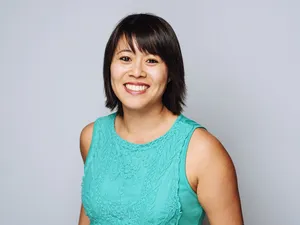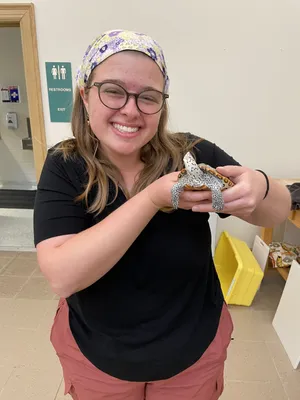Inspiring Tomorrow’s Earth Optimists Today
An afterschool club in partnership with the Smithsonian and the World Wildlife Fund aims to build environmental leadership skills through hands-on experiences and exposure to a wide range of “green” careers
:focal(640x363:641x364)/https://tf-cmsv2-smithsonianmag-media.s3.amazonaws.com/filer_public/99/9b/999b602c-b3fa-4926-8791-483fedd53d7c/eoyal1.png)
“Can you eat this?” Esraa asked. She picked a small flower from the middle of the trail and showed it to “Ms. Jessica.” “I’m not sure, you might want to ask our guide Krystal - she knows a lot about this stuff!” said Jessica Leung, Manager of Early Talent Diversity Programs at World Wildlife Fund (WWF).
Esraa walked up to Krystal Bagnashi, Smithsonian Conservation Biology Institute (SCBI) research assistant, who explained to her and the group of nine International High School at Largo (International) students how to navigate things that were safe to eat in the Shenandoah Valley. Alongside Rachel Hoffman, another SCBI research assistant, the two co-led the group through a forested area to help identify common trees and bushes like American beech, pawpaw, and Black walnut.
Esraa, alongside 26 other International students, participated in a two day, overnight trip to SCBI and Eldon Farms. The field trip was part of the Earth Optimism Youth Action and Leadership program, (EOYAL) a collaboration between Smithsonian and WWF. EOYAL connects students from underrepresented communities to conservation-based careers and builds environmental leadership skills.
/https://tf-cmsv2-smithsonianmag-media.s3.amazonaws.com/filer_public/50/1e/501e1d6e-d72e-49a2-9b37-a07c80e45feb/eoyal2.png)
The SCBI experience was the fifth field trip of the school year, with other visits including the National Zoo, Smithsonian Environmental Research Center, National Air and Space Museum, and the National Museum of Natural History. Smithsonian and WWF staff visit the school regularly as leaders of the after school green club, Society of Earth Savers.
This group of International students are just one facet of the program across the country. EOYAL currently operates in eight states across 12 high schools through partnerships with Smithsonian Affiliate organizations. This national approach allows for hyper-local connections and peer-to-peer networking between students from different regions. For example, in spring 2024 EOYAL hosted six paid interns, known as the Earth Optimism Ambassador Council, who launched an Instagram campaign highlighting their schools’ Earth Optimism projects. The Council’s students were from Miami, Florida; Helena, Montana; Largo, Maryland; and San Francisco, California.
National EOYAL participants are all enrolled in Title I high schools, which is defined as an institution receiving significant funding from the Federal Government, due to a high percentage of the school’s students at or below the poverty line. Uniquely, participants from International are all English learners, with cultural heritage rooted in over 13 countries across Latin America, Africa, Middle East, and South Asia. While some students may have grown up in rural areas in their home countries, few have taken prolonged trips outdoors to be amongst wildlife and extensive green spaces. Research has well documented that low-income or otherwise disadvantaged communities will disproportionately experience the effects of climate change, so deepening environmental literacy, action and leadership among this constituency is critically important.
For example, standing deep in the forest with the SCBI research assistants, student Isatu was asked how she felt about the field trip several hours into the outing, and remarked, “I have never been this deep in the forest before because I was always scared…I feel like I have strength now and courage and I can do it again.”
The program’s mentorship, field trips, and practical workshops are designed to support youth in actively caring for the environment in their local communities - with the additional goal of inspiring them to pursue career paths in this field.
/https://tf-cmsv2-smithsonianmag-media.s3.amazonaws.com/filer_public/5d/03/5d031d37-395b-4088-bc6b-f13f48905b26/eoyal3.png)
One student expressed the field trip’s impact on him. “I feel so happy right now,” student Elmer told Smithsonian and WWF adult chaperones at the end of the overnight field trip. He spoke to Brian Evans, a Smithsonian staff scientist, on how to find paid conservation opportunities after graduating high school. Elmer reflected on how the Shenandoah valley landscape and immersive nature experiences reminded him of his home country of Guatemala, where he immigrated from two years ago. Upon graduation in 2025, he hopes to find a path forward that allows him to “save the environment and take care of the animals.”
It can be difficult to feel like one is making a difference, especially with an issue as existential as climate change. The fight becomes even more challenging when attempting to educate children about the future of the planet, especially when those youth come from disadvantaged backgrounds. How does one justify teaching about the climate crisis to students who may be food-insecure or struggling with traumas from their home countries? Why should students, who are already in a desperate situation, even care about climate change, when it seems utterly helpless?
The Smithsonian and WWF attempt to answer these questions through the EOYAL program model. Focusing on exposing students to nature and helping them feel safe in the outdoors prove to be an effective way of answering some of these critical questions. So many of the students in the program have never visited a zoo, gathered around a campfire, or gone hiking. By bringing our students to places like SCBI or a recycling center, the program not only exposes them to opportunities that seemed previously inaccessible, it also shows them the myriad of career options that exist in the green sector. Many of our students think their career opportunities are limited (whether due to finances, family history, or a lack of representation). Some had never heard of many of the existing “green jobs” prior to exposure through EOYAL guest speakers and field trips.
EOYAL stresses education through exposure, experience, and opportunities; students learn from experts who look like them, through hands-on activities on field trips designed specifically for them, and through organizations in their communities, where they are paid for their work.
This additional step of forming partnerships with community organizations (and NGOs and other government agencies) shows our students that adults are invested in them, and actively listen to what they have to say. It also provides extra support for EOYAL’s teacher partners, who often lack the time or resources to provide these kinds of experiences. The reason we are able to get students to the point of “I have strength and courage now” is because of our community and teacher partnerships. The impact of EOYAL on students demonstrates the benefits of formal-informal educational collaborations.
Teachers are selfless, caring, enthusiastic, and creative individuals who put their students first, above all else. Teaching climate change can be daunting, but educators look at this challenge and see opportunities for learning from students, incorporating cultural and community knowledge into lessons, and endless and boundless optimism. We learn with our students and make sure they know their voices are heard.
Editor's Note: To learn more about this program, please visit the EOYAL website at: https://affiliations.si.edu/eoyal/. Plus, join the co-authors of this article for the Smithsonian National Education Summit on July 16-18. Leung and Kemp will present an online session with Katy Fenn of World Wildlife Fund and Lynson Ablaza of Prince George's County Public Schools on Tuesday, July 16 at 1:00 p.m., Eastern. More information about the session line-up and free registration is available here: https://s.si.edu/EducationSummit2024.

